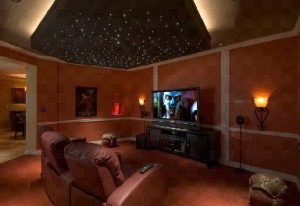Home Lighting
By Craig DiLouie, LC
 Home theaters allow you to bring the ambiance, drama and excitement of the silver screen into your home. And lighting plays a key role in the experience.
Home theaters allow you to bring the ambiance, drama and excitement of the silver screen into your home. And lighting plays a key role in the experience.
As people enter the home theater, it is first experienced as a non-theater space. When the movie starts, it is then experienced as home theater. The lighting must address both uses of the space. This can be accomplished by layering light, or combining different types of illumination. Typical layers of light might include ambient (lighting for atmosphere), accent (light focused on points of interest, such as art on the walls), task (higher light levels focused locally for specific tasks such as reading) and step or pathway lighting. Use the following tips to help your home theater shine even when the screen is off.
Ambient illumination. General atmospheric lighting should generally be soft and muted, with good shielding of the light source. Dark, non-reflective finishes will likely be used on the ceiling and walls to avoid unwanted color reflections from room surfaces back onto the screen. Bright luminaires (light fixtures) surrounded by these dark surfaces can produce excessive brightness contrast and perceptions of glare.
Accent lighting. Enrich the first impression of your home theater by directing attention to paintings, movie posters or other art with accent lighting. Decorative wall sconces and recessed downlights can provide ambient lighting, although recessed downlights should not be mounted directly over the seating area. Instead, decorative ceiling lighting, indirect lighting or color LED lighting can be employed to create a sense of atmosphere.
Task lighting. Home theaters can be used for activities other than movie watching. Task lights, such as tabletop luminaires, allow you to use the theater for reading as well.
Step or pathway lighting. To ensure the safety of you and your guests, leave step or pathway lighting on during the entire viewing. Note that some low-level wall lighting may also be kept on during viewing to reduce contrast. In a commercial theater, which uses a front-projection system, the movie should be viewed in near total darkness. In a home theater, a bright screen in near total darkness can result in excessive contrast and the perception of brightness being too high—enough to cause eyestrain.
Each of the above layers should be separately controlled by a lighting control system providing a combination of switching and dimming to create scenes or moods supporting different uses of the space, including optimal media viewing. The control system should allow these scenes to be programmed, stored in memory and recalled at the push of a button. The result is a living space that instantly transforms into home theater offering an exciting cinema experience with optimal viewing conditions.
Home Theater Lighting: What You Need To Know
- Home theater lighting should be soft and muted, with good shielding of the source
- Avoid downlighting directly over the seating area
- Step/pathway lighting provides safety during viewing
- Dimming these layers provides flexibility and supports optimal viewing conditions